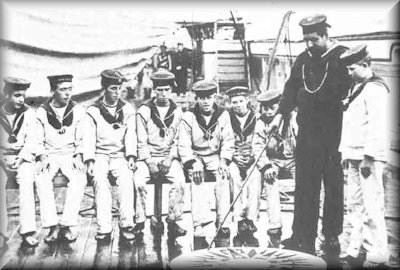‘Schoolies’: Teachers of the Royal Navy and Royal
Marines 1700-1914
1.Raise the age of admission to the Britannia to 18, and accept no boys of less than 16 1/2 years. 2. Abolish the office of naval-instructor and direct his work to be done by sea-going officers of the executive branch. The increased age of the young gentlemen first going to sea would render the further supervision of their professional education a much less onerous business than it now is. One might surmise that Clowes foreshadowed the end of the long and uneasy marriage of the chaplain and naval instructor, and the closure of the naval instructor branch in 1903, the same year sail training brigs went out of service. There is further reference to the branch’s revival in 1915 with the assertion that this time naval instructors were a separate entity, distinct from men of the cloth. Statements of the branch’s demise and resurrection are confusing against official records: ‘An executive officer will be detailed in every ship for supervising the instruction of the Midshipmen, whether a Naval Instructor is borne or not.’ (The Parliamentary Debates, Fourth Series, Vol. 152, Appendix 1 (Personnel), 13 February-2 March 1906). Also King’s Regulations & Admiralty Instructions of 1913 specifically list the naval instructor’s general duties. At this time, the Regulations also directed the chaplain to be an educational overseer, so religious men were hardly divorced from academics: Supervision of School. When school is held [the Chaplain] is to visit it daily and see that the Naval Schoolmaster, or the person acting in his place, is attentive to his duty and diligent in teaching the boys placed under him and those who may choose to seek instruction from him. He is frequently to examine the progress made by them in secular education, and, at the end of each quarter, he is to report the result in writing to the Captain; noting such as deserve commendation or otherwise. He is to examine the school register to see that it is kept in accordance with the provisions of Article 390, and initial it weekly. Also ‘When no Chaplain is borne, [the Naval Instructor] is to carry out the Chaplain’s duty as regards ship’s school and library’. Even casualty records bear evidence contradicting Rodger: Chaplain and Naval Instructor the Rev George S. Kewney, Queen Mary (Jutland, 31 May 1916) and Chaplain and Naval Instructor the Rev. William Hall, Venerable (illness, 4 November 1916) (CWGC). In spite of the somewhat intrusive clerics, the growth in schoolie commissioned and warrant ranks in the early 20th century signalled increased professionalism and respectability for the once outcast shipboard civilians of so long ago. |
